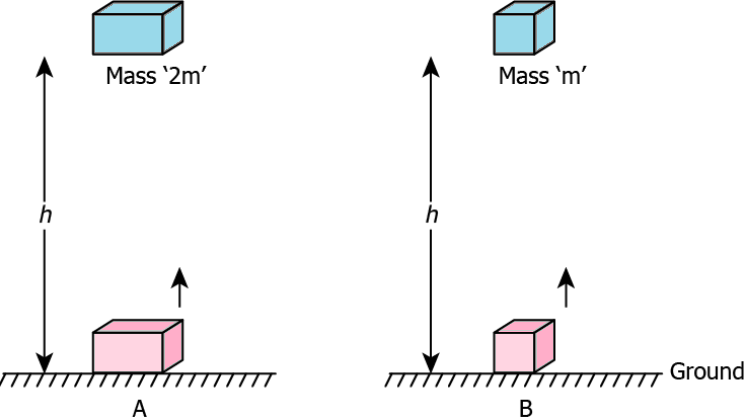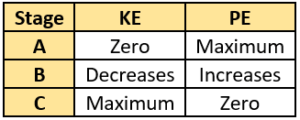Hint: Judge situations to identify where work is done according to scientific conception and calculate the magnitude of work.
Question.1. Which of these is an example of scientific work done?
(a) Standing with a load of 2 kg on the head for 5 minutes
(b) Playing video games when sitting on a sofa
(c) Sitting on a chair and reading a book
(d) Climbing stairs of a bridge
Question.2. A force of 20 N acts on an object. It causes a displacement of 500 cm in the direction of force. What would be the work done in Nm on the object?
(a) 1000
(b) 100
(c) 25
(d) 4
Ans.1. (d) Climbing stairs of a bridge
Ans.2. (b) 100
Hint: Calculate the total work done on an object when force is applied in varied directions and determine its nature.
Question.3. A boy pushes a lawn mower to a total distance of 125 m over the grass with a force of 60 N directed horizontally. How much work is done in joules by the boy?
(a) +7500
(b) -7500
(c) +2.03
(d) -2.03
Question.4. An object is moving with a uniform velocity along a particular direction. A retarding force of 5 N, is applied in the direction as shown.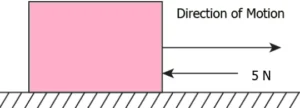
(a) -5 J
(b) -25 J
(c) 5 J
(d) 25 J
Ans.3. (a) +7500
Ans.4. (b) -25 J
Hint: Comprehend energy and calculate the amount of work an object is capable of doing.
Question.5. An object of mass 25 kg is at a height of 8 m above the ground. How much work is this object capable of doing? Given g = 9.8 ms^{-2}.
(a) 1960 J
(b) 2000 J
(c) 19600 J
(d) 20000 J
Question.6. The kinetic energy of an object weighing 10 kg moving with a velocity of 5 m/s is 125 J. What is the maximum amount of work that can be done by the object?
(a) 5 J
(b) 10 J
(c) 125 J
(d) 1250 J
Ans.5. (a) 1960 J
Ans.6. (c) 125 J
Hint: Relate kinetic energy to motion and calculate kinetic energy possessed by the objects.
Question.7. What would be the kinetic energy possessed by an object of mass, ‘2m’ and moving with a uniform velocity, ‘v’?
(a) \frac{1}{2}mv^{2}
(b) mv^{2}
(c) 2mv^{2}
(d) 4mv^{2}
Question.8. A car weighing 500 kg is moving with a uniform velocity of 15 m/s. What is the kinetic energy possessed by the car?
(a) 56.250 kJ
(b) 112.500 kJ
(c) 56250 kJ
(d) 112500 kJ
Ans.7. (b) mv^{2}
Ans.8. (a) 56.250 kJ
Hint: Comprehend energy transfer and write an expression for the kinetic energy of an object.
Question.9. An object of mass 200 g moving with velocity 50 m/s. What is its kinetic energy?
(a) 2.1\times 10^{5} J
(b) 2.0\times 10^{5} J
(c) 2.8\times 10^{5} J
(d) 2.5\times 10^{5} J
Question.10. A particle is thrown upward with some kinetic energy. What happened to its kinetic energy at the highest point or height it reaches?
(a) Its kinetic energy is lost;
(b) It’s all kinetic energy is absorbed by the air;
(c) Its kinetic energy is converted to potential energy;
(d) Its kinetic energy is remain same;
Ans.9. (d) 2.5\times 10^{5} J
Ans.10. (c) Its kinetic energy is converted to potential energy
Hint: Relate potential energy to position and calculate potential energy possessed by the objects.
Question.11. An object of mass ‘x’ kg is placed on the surface of Earth. What is the energy possessed by the object by the virtue of its position? Given g = 9.8 ms^{-2}.
(a) -9.8x J
(b) 0 J
(c) 9.8x J
(d) \frac{x}{2} J
Question.12. Compare the energy possessed by the virtue of position for the 2 bodies shown below.
(a) By virtue of their positions, the energy possessed by body A is half the energy possessed by body B.
(b) By virtue of their positions, the energy possessed by body A is twice the energy possessed by body B.
(c) By virtue of their positions, the energy possessed by body A is 4 times the energy possessed by body B.
(d) By virtue of their positions, the energy possessed by both Body A and Body B is the same.
Ans.11. (b) 0 J
Ans.12. (b) By virtue of their positions, the energy possessed by body A is twice the energy possessed by body B.
Hint: Generalise the law of conservation of energy to situations of energy transfer and calculate the total energy of an object.
Question.13. A 50 kg skydiver jumps from a height of 20 m. What would be his kinetic and potential energies when he is halfway down? Assume g = 10 ms^{-2}.
(a) KE = 5,000 J; PE = 5,000 J
(b) KE = 0 J; PE = 10,000 J
(c) KE = 10,000 J; PE = 0 J
(d) KE = 10,000 J; PE = 10,000 J
Question.14. Refer to the image below.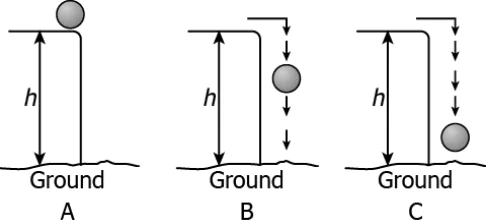
(a) 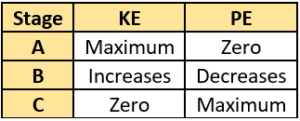
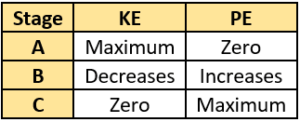
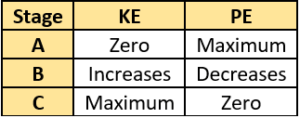
Ans.13. (a) KE = 5,000 J; PE = 5,000 J
Ans.14. (c)
Hint: Calculate power and assess the efficiency of work done.
Question.15. The power expended by 4 persons to do a task is shown in the table below.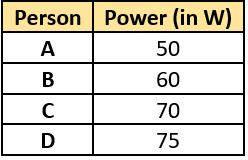
(a) A
(b) B
(c) C
(d) D
Question.16. A man of mass is 60 kg climbs up 50 steps of a stair in 2 minutes. If each step is 20 cm high, calculate the power used in climbing the stairs. [Given g = 10 ms^{-2}]
(a) 50 W
(b) 250 W
(c) 3000 W
(d) 6000 W
Ans.15. (d) D
Ans.16. (a) 50 W
Hint: Get conversant with commercial unit of energy.
Question.17. A machine do a work of 100 joule in 20 second. What is its power?
(a) 20 watt
(b) 80 watt
(c) 5 watt
(d) 2000 watt
Question.18. Which of the following is equal with Newton-meter?
(a) Joule
(b) Horse Power
(c) Watt
(d) Pascal
Ans.17. (c) 5 watt
Ans.18. (a) Joule
Hint: Calculate total energy consumption and determine total cost in households and industries.
Question.19. A factory has eight machines of 1200 W each. If each machine runs for 10 hours a day, find the cost of electrical units’ consumption per day if the rate per unit is 4.00 rupees?
(a) 96 rupees
(b) 120 rupees
(c) 384 rupees
(d) 3840 rupees
Question.20. A household has four bulbs of 100 W each. If the bulbs operate for 10 hours daily, find the monthly expenditure incurred? (Cost of 1 unit = 2.50 rupees)
(a) Rs 75
(b) Rs 250
(c) Rs 300
(d) Rs 2500
Ans.19. (c) 384 rupees
Ans.20. (c) Rs 300


